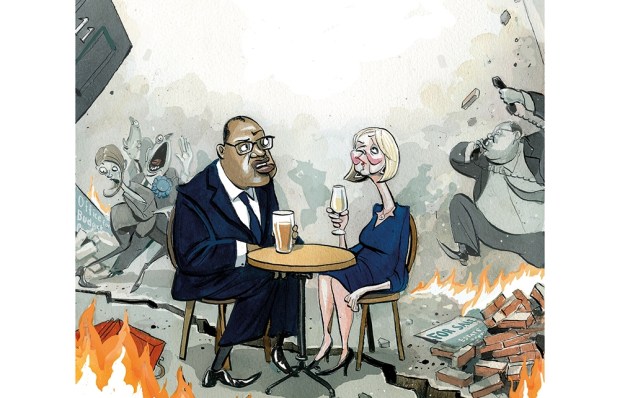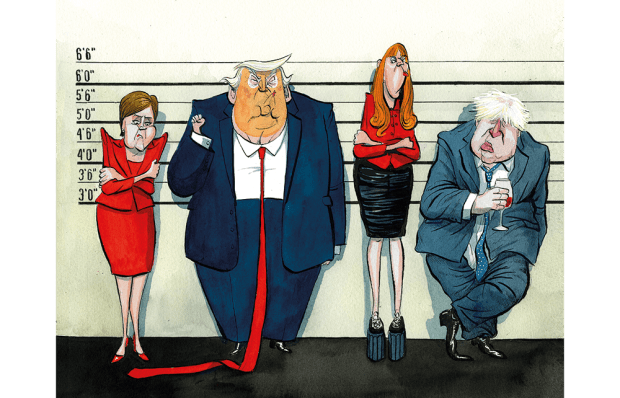When polls started to show Liz Truss miles ahead of Rishi Sunak in the Tory leadership contest, her team adopted a cautious campaign strategy. Why gamble on another interview with Nick Robinson when last time she had struggled to name a single economist who backed her economic plans? Eventually she landed on Professor Patrick Minford, an academic at Cardiff Business School and a bullish Brexiteer. Minford went on the record calling for interest rates to rise to 7 per cent, which Truss then had to defend and deflect.
But that moment in the Robinson interview, widely reported as a humiliation, turned out to be one of the most helpful points in her campaign. Within days, like-minded economists were grouping together to praise her tax-cutting agenda. She went from seemingly having no support for her economic vision to having the endorsement of established and respected economists. The phrase ‘Trussonomics’ was first used as a dig at the Foreign Secretary’s eternal optimism and radical economic ideology. Now, since it’s likely to be Britain’s new economic strategy in the days to come, there are more serious attempts to work out what it might mean.
So far, the details have been a mystery even to her supporters because she’s been running a closed campaign. ‘There’s an iron wall around the inner circle,’ says one frustrated MP who is backing Truss. ‘They don’t want policy suggestions from us.’ The big political and economic decisions have instead been hashed out by a small number of her advisers. But while MPs struggle to get their economic advice heard, outside advice is funnelling through. Minford, Gerard Lyons and Julian Jessop make up the trio of economists closest to the Truss campaign (although they are not officially part of the team).
All three men have long-standing Westminster connections. Lyons, the former chief economist at Standard Chartered Bank, offered up economic advice to Boris Johnson over the years. Minford is a forecaster who was on good terms with Margaret Thatcher. Jessop worked at the Treasury and in banking before he became chief economist for the Institute of Economic Affairs, the free-market thinktank, where he still acts as a fellow.
For Lyons, now chief economic strategist at Netwealth, the decision to advise Truss’s team has been a decade in the making. He first came across her soon after she entered parliament. He had read Britannia Unchained, a pamphlet published by the Free Enterprise Group of Tory MPs, and dispatched his researchers to find out who had written it. The answer came back: Liz Truss. He got in touch with her, and they remained in contact.
‘The tax take is egregiously high,’ says Lyons. ‘We are the only G7 country to have tightened fiscal policy into a likely global downturn.’ He sees Truss as the only politician willing to confront a failed high-tax consensus.
This is also what brought Jessop to Team Truss – he wants to tackle what he sees as a failed orthodoxy. ‘The Treasury has been too quick to believe you need to start paying the debt down by raising taxes, both personal and corporate taxes,’ he says. ‘Far better to let the deficit take the strain.’
Isn’t that a recipe for instant instability? Won’t the markets punish Britain with far higher borrowing costs, as Sunak says? Jessop says the markets will recognise a strategy for higher growth and finance the transition. ‘If tax cuts do mean more borrowing in the short term, I’m completely relaxed about that,’ he says. ‘I suspect the markets will be as well. If the consequence of this is a stronger economy and stronger public finances over the longer term, that’s a positive outcome that markets will actually quite like.’
If Truss enters No. 10, it is probable she will work with a new chancellor (Kwasi Kwarteng is tipped for the role) to change the Treasury’s fiscal rules to give the government more room to borrow. ‘First of all, the rules will be a lot simpler,’ says Jessop. ‘At the moment we’ve got a complicated set of rules that cover a whole different range of variables and time-scales.’
Minford’s first job in the Treasury was in 1971. He’s seen fiscal frameworks come and go and argues that there’s no point in following rules that suppress economic growth. ‘We have policies in place which are raising taxation, that damaged growth in order to satisfy short-run borrowing constraints put forward by the Treasury.’ And anyway, says Minford, such rules get quietly ignored, changed or dropped – which is what happened during the pandemic. The prime example, he says, was the government’s ‘lunatic proposal’ to hike taxes ‘just when we need taxes to be low in order to fuel a proper future growth rate’.
The three economists broadly agree that it’s the long-term trajectory of the debt that matters, not short-term spikes in borrowing. ‘The markets need to have a view that you want to keep the public finances in shape,’ says Lyons. A decent rule, he says, is to ‘reduce the ratio of debt to GDP over time’.
But this is just the first part of a three-pronged Trussonomics strategy: cut taxes, tackle double-digit inflation, then kick-start a stalled economy with some pro-growth reforms. So far, it’s the second part of this plan that has turned the most heads, as Truss hasn’t hidden the fact she blames much of the UK’s inflation crisis on the Bank of England.
She has been raising questions about monetary policy, implying she thinks the Bank should increase interest rates. But since Truss and her economic advisers are adamant that there are no plans to renationalise the Bank, how exactly would she make central bankers play ball?
All three express similar frustration that the transfer of monetary policy from politicians to the Bank has, over the past 25 years, morphed into a ban on any criticism of the Bank’s decisions. ‘The Bank of England has clearly made some mistakes [during the pandemic] and it’s perfectly reasonable to ask what went wrong,’ insists Minford. The Bank’s mandate after all – currently to target 2 per cent inflation – is set by the prime minister. Might that change? ‘I don’t think if you asked her now, she would give you an answer to that specific question,’ says Lyons. Given that inflation has (to put it mildly) exceeded its 2 per cent target, he says there’s a simple job to be done: ‘Let’s re-examine the [Bank’s] remit to make sure it’s fit for purpose.’
But the crux of Truss’s plan is to create space for the Bank to be bolder. ‘One of the reasons why the Bank of England hasn’t raised interest rates as much as some people would like is because fiscal policy has been tightened,’ says Jessop. ‘Simply the fact that fiscal policy would be looser under Liz Truss means that there’d be more room for the Bank of England to raise interest rates.’ This would be a long-overdue correction, says Minford, to the ‘unnaturally low’ interest rates that dominated the 2010s; ‘a disastrous mistake’, he says, which crushed productivity and was made worse by a lack of fiscal policy.
Speaking to Truss’s most trusted economists, it’s clear that their perspective on the deficit has shifted substantially over the past decade. The free-market narrative after the financial crash was that cheap borrowing – and Gordon Brown’s spending splurge – had ruined the public finances and that austerity had not gone nearly far enough to get them in order. Now these same economists seem remarkably relaxed about climbing deficits and higher public debt. What’s changed?
‘When the facts change, your opinions change,’ Jessop tells me. ‘Ten years ago, I would have been much more conventional in my thinking that you need to get the budget deficit down as quickly as possible. But it’s clear that isn’t working. You need a more flexible approach focused on what really matters: the long-term sustainability of the public finances.’
‘We’ve drifted into consensus, which is that you must never spend anything,’ says Minford. ‘The Conservative consensus has ricocheted from you can do anything you like under Macmillan; the Osborne version is you can’t do anything at all.’ This ruins any opportunity, he says, to achieve ‘an optimal tax environment for growth’, which is the only way to get ‘long-run control of spending’.
A change in post-crash thinking isn’t the only disruption taking place. Much has been made of Truss’s hints that her next Budget may not come with the now-traditional assessment from the Office for Budget Responsibility. Politically, it’s not hard to see why she might want to drop it: the OBR (set up by Osborne in 2010) runs lots of forecasts. Its next report is likely to be so bleak as to overshadow any good news she may have in her Budget. She’s all but certain to be accused of spin, trying to exaggerate the impact of tax cuts in tackling this winter’s cost-of-living crisis.
But her economist backers aren’t especially worried. Lyons says it’s a question of priorities, not spin. The OBR needs time to evaluate the impact of various interventions, but Truss wants to move fast to have support ready for winter. ‘The timing of the emergency Budget can’t be constrained by whether the OBR has had time to do their forecast,’ Lyons says. The OBR announced last week that it is operating an ‘exceptionally accelerated timeline’ to deliver a fiscal outlook in time for any announcement. But not even a catastrophic forecast from the independent body is likely to change Truss’s policy agenda over the next few months. ‘She has committed to cut taxes,’ says Jessop. Come hell or high deficit forecasts, those cuts have to be delivered.
What will the tax cuts look like? Lyons points out what’s already evident: reversing the corporation tax hikes, which were set to rise from 19 per cent to 25 per cent for the largest companies next year; scrapping the new National Insurance levy (but keeping the £13 billion uplift for health and social care); and a temporary freeze on green levies to help with energy bills.
Truss originally rejected more ‘handouts’ to help with bills this winter – insisting that support would be delivered the ‘Conservative way’ instead by ‘lowering the tax burden’ – but she has pivoted in recent weeks, preparing to add to the £15 billion package announced in May to provide direct support. Still, she wants to use tax cuts where she can, and is considering a 5 percentage point cut to VAT – a move which Jessop has called the ‘nuclear option’, though he says ‘the scale of the crisis means everything should be on the table’. There’s also the tricky political business of having to increase it again at some point: the cut would leave close to a £40 billion gap in the public finances and in the meantime would do nothing to help with the cost of food or children’s clothes, both of which are exempt from VAT.
And what about the third factor of Trussonomics: going for growth? The OBR is famously sceptical about the effect of pro-growth reforms. Its critics point out it constantly underestimated how much the Cameron-era reforms would increase employment, for example. But the Tory party has its own problems with growth strategy, internally at odds over whether it should have an ‘industrial strategy’. When Sajid Javid was business secretary, he said that the words ‘industrial strategy’ should never come out of Tory mouths. Theresa May went on to create an entire department around the concept. Truss’s instincts are laissez-faire. ‘What’s reassuring is that she doesn’t want to micromanage from the centre,’ says Lyons. ‘Therefore I don’t think it’s a case of saying: “This sector will grow and that sector will not grow.” I think she quite sensibly will focus on incentives – particularly the incentives to innovate.’
One sector Truss has never been shy to criticise is the housing sector. An avid Yimby (Yes In My Backyard), she has been vocal about overhauling the planning system and building hundreds of thousands more homes. But Tories have consistently struggled to live up to their manifesto pledge to build 300,000 houses a year, and this is unlikely to change soon under Truss. ‘There are some things that are probably too politically difficult to do now, ahead of the next election, until you’ve got a mandate,’ admits Jessop. ‘I would like her to go into the next general election with a manifesto that does include meaningful changes on things like planning reform and health finance. That may be too ambitious. It may be that it has to be in the manifesto after that.’
The question of ‘health finance’ will be tricky for the Tories. With the NHS already on track to make up 45 per cent of day-to-day government spending in the next few years, quite a few Tories talk about the need for big NHS reform, saying it will have to happen sooner or later.
Both Truss and Sunak took the subject off the table as soon as the leadership campaign began. Can spending ever be tamed while the NHS remains off limits? Lyons points out that when attitudes change, they change quickly. ‘If one goes back to, say, the May 1979 Conservative party manifesto under Mrs Thatcher, it didn’t even have the word “privatisation” in it… Suddenly by 1982, 1983, it was one of the buzzwords. That had not appeared in ’79, but it occupied a very centre stage by the subsequent general election in ’83… The fact that something might not be centre stage now [does] not imply it will not become more important in the future.’
One thought I can’t escape when speaking to Truss’s economic gurus is that part of the Trussonomics equation is still missing: to get debt down in the long term, surely public spending cuts are necessary. Yet Truss is pledging tens in billions of pounds of extra spending. She wants big rail projects and would renew the hugely expensive triple-lock on pensions. While she plans to scrap the National Insurance rise, she will keep the plan to subsidise care-home costs for wealthier pensioners – a policy David Cameron ruled out as unaffordable. And all this will come on top of her £50 billion tax cut pledges.
If Labour were proposing a similar borrow-and-spend agenda, wouldn’t the Tories be shouting about magic money trees? The difference, says Minford, is the ‘combination of policies’ which Truss is putting forward. Truss is offering temporary spending packages with tax policies that spur growth, he says, while Labour usually combines more spending with higher taxes on businesses and ‘the rich’, with ‘no real commitment to solvency’.
Alarm bells did sound for some when Truss’s team proposed regional pay for public sector workers, only to drop the idea just hours after the outrage began. ‘The important lesson from the regional pay board stuff was that you have to build up support and understanding for what that type of [policy] means over a number of years,’ says British economist Ryan Bourne, who works at the Cato Institute in Washington DC. Bourne is not advising Truss’s campaign, but he worked closely with her through the IEA’s Free Enterprise Group and has stayed in touch with her since. ‘From what I’ve heard from Liz in recent days,’ he says, ‘she’s aware of that.’
The U-turn over regional pay raises perhaps the most important question of all: does Truss buckle? Will her economic agenda survive the pressures of what this winter has in store? Not many Tories would say they can predict the next few months with any confidence, but they are bracing themselves for their toughest time in office yet.
‘It’s precisely because things are going badly that I think you need a radical shift,’ says Jessop. Truss, he believes, has ‘the vision to do things radically differently’. As the details of Trussonomics come to light, it’s clear her entrance into No. 10 would close a chapter on Tory (and Treasury) economic orthodoxy. The next chapter is where we discover if her plans will do anything to fix the mess we’re in.
Got something to add? Join the discussion and comment below.
Get 10 issues for just $10
Subscribe to The Spectator Australia today for the next 10 magazine issues, plus full online access, for just $10.
You might disagree with half of it, but you’ll enjoy reading all of it. Try your first month for free, then just $2 a week for the remainder of your first year.















Comments
Don't miss out
Join the conversation with other Spectator Australia readers. Subscribe to leave a comment.
SUBSCRIBEAlready a subscriber? Log in